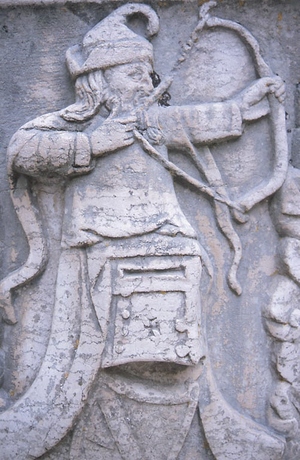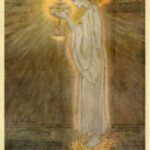There are certain myths and legends that just don’t seem to die. Some are mystical and some are rooted in history. Some are fantasy and some may very well be fact. But which is which? What is true and what is myth? We will explore some of these myths and fantasies over the course of the next few articles, beginning here with one of my favorites – – the legend of Robin Hood.
There are people who deny the existence of Robin Hood, arguably England’s most famous myth. But there are also those who just as defiantly insist that he did exist. So where did these legends begin? And if there is any truth, which parts are true and which are make believe? Who was Robin Hood?
We may not be able to answer these questions with absolute authority, but perhaps we can shed some light on the myth and outline the various points of truth.
The earliest writings suggest that Robin Hood may have existed in the 13th Century. However, some accounts suggest he was born in the 12th Century and still others have him placed squarely in the 14th Century. The differences in time can be explained by exploring the various men who may be responsible for the Robin Hood legend.
Many references point to a 1225 reference to a Robert Hod. History shows that York sought a criminal by that name; even putting a bounty on his head of 32 shillings and 6 pence. Unfortunately, there is no further reference of the man’s specific crimes or anything to prove whether or not he was ever captured; making it impossible to determine whether or not he was the anti-hero.
In 1850, another historical document that was found detailed the actions of a forester by the name of Robert Hood. He certainly seemed to fit some of the story that we know so well. He was born at Loxley and his record indicates a series of minor offenses, one of which was petty theft. According to recorded accounts, Robert may have become an outlaw because of his support for the Earl of Lancaster in his rebellion against King Edward II.
The Earl of Lancaster mounted an army and attempted to overthrown the King, however, his plan failed and he was executed. All of the men who were known to be loyal supporters of Lancaster became automatic criminals and were stripped of all their known possessions. Some believe the group of outlaws banded together and hid in the woods. It isn’t inconveivable that could have become the “merry men” that helped Robin Hood rob from the rich and give to the poor.
There are many other people who were, over the years, equated with the “Robin Hood” name. They included:
Robert fitz Ooth, who was also born in Loxley. He was outlawed in the 12th Century after which his lands were transferred to the Earl of Chester. Most people disagree that fitz Ooth fits the myth in any way, other than the fact that he was once wealthy and had his lands taken from him.
Another possible candidate for Robin Hood fame is Robert de Kyme. Born of noble Saxon blood, de Kyme was outlawed in 1226. Charges claim that he robbed from the King and “disturbed the peace.” Supposedly, Robert de Kyme held title to lands that had been usurped by the Earl of Huntington, but couldn’t get anyone to listen to his claims. In frustration and anger, it is believed that he retreated to the forest to plan his revenge.
Another theory suggest that the name Robin Hood was actually a pseudonym used throughout multiple generations of a family named Foliot. This would certainly explain the many inconsistencies regarding the time frame during which Robin Hood’s lived, which spans anywhere from the 12th to the 14th Century.
The family’s proximity to Sherwood Forest also lends some credence to the theory. Coupled that with the fact that Foliot family was well known for its intense chivalry and sense of fair play and the theory becomes even stronger. Many believe that the family used an “alias” in order to protect their identities because of the lawless society in which they lived.
In 1510 a poem entitled “A Lytell Gest of Robin Hood,” seemed to offer specific clues to the identity of the outlaw. It made references to the locations of Nottingham, Barnsdale, and Sherwood and specifically mentioned the Sheriff of Nottingham.
There is no doubt that in the 13th Century people lived in a violent and repressed society. Most people were dirt poor, exploited by corrupt politicians seeking to further enhance their own personal wealth. Justice was not a real part of the times; another symbol of political corruption. Therefore, it isn’t at all surprising that the people would hope for a hero to deliver them.
One thing is certain. Robin Hood, as a character of either fact or fiction, represents the triumph of good over evil. He represents the inalienable rights of man to be free. His struggle is that of all mankind. He seeks to alleviate the oppression and the misery of the poor that is often caused by the greed of the rich. He is for justice and equality for all of mankind and, as such, is a noble representation of a folk hero.
On one thing, most myths and legends agree; that Robin Hood used a long bow as his weapons. In all accounts he was an expert marksman, rivaled only by his dear friend Little John.
Tradition often tells a story whereby Robin and Little John shoot an arrow from the top of a monastery in an effort to determine who was the better shot. Robin shot in one direction and Little John in the other. The Abbott then had stone markers made to mark the spots where the two arrows fell. One is called Robin Hood’s Close; the other Little John’s Close. A deed found in the 1700’s proves the existence of stone markers with those names.
Another part of the myth that seems to remain in tact, no matter the story, is how Robin Hood died. However, the events around his death do vary slightly from story to story.
As the legend goes, Robin became ill and Little John took him to Kirklees Priory in which a relative of Robin’s was in charge. He died there, having been bled to death. Some say he was deliberately killed because the prioress was attempting to cover her many sexual indiscretions. Others say because a monk – – Roger of Doncaster – – bribed her to kill the outlaw.
Only minutes from death, Robin found enough strength to blow his horn for Little John. It was, of course, too late to save the hero’s life. However, it provided Robin with enough time to shoot an arrow from the tower window and to elicit John’s promise to bury him in that spot.
A grave remains in that spot today, along with two others, that of a child and Elizabeth Stainton, who is believed to have been the relative who murdered him. The validity of the epitaph on the grave has been obviously been questioned. There is no real evidence to prove whether or not anyone actually resides there.
Oftentimes, legends ring more truthfully in our hearts and minds than any real life hero. For reasons that me might not quite understand, their strength lies in their ability to make us strive to be better human beings. They make us see what we sometimes fail to see on our own: That each of us much reach out to help our fellow man.
In that respect, we owe legends – – like Robin Hood – – our undying gratitude. In gratitude, we can say thank you by continuing to spread their legend on to the next generation so that the message never fades away. Long live Robin Hood!
Although there is no real proof that Robin Hood actually existed, neither is there proof to disprove it. Whether he was a single man whose myth simply grew to legendary standards or the combination of several men over an extended period of time, we may never know. In truth, it may not even matter.




